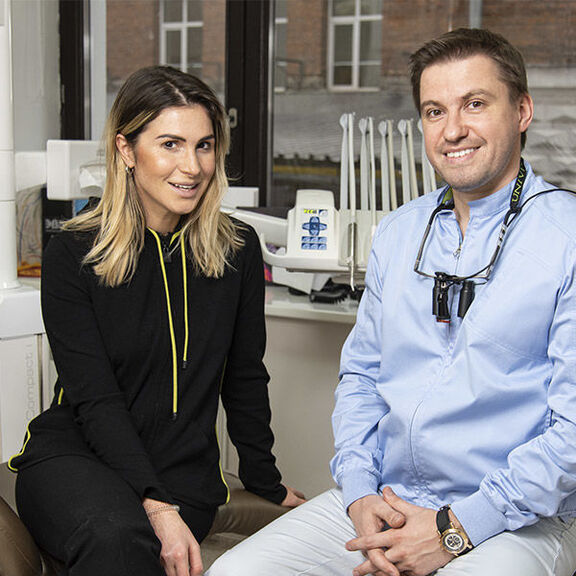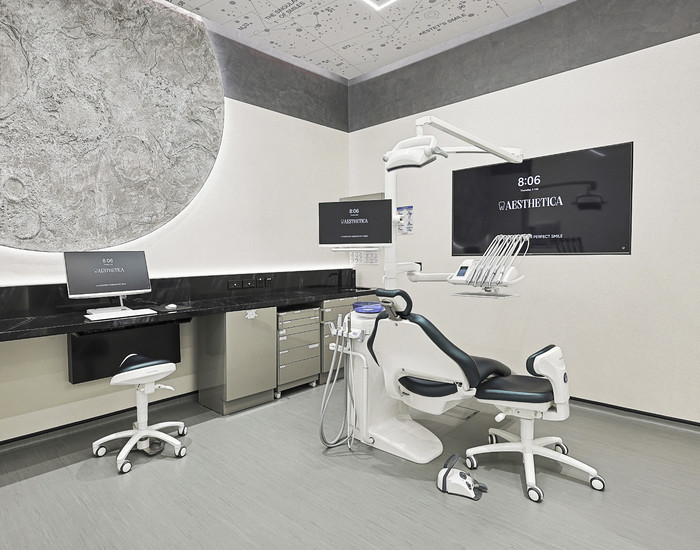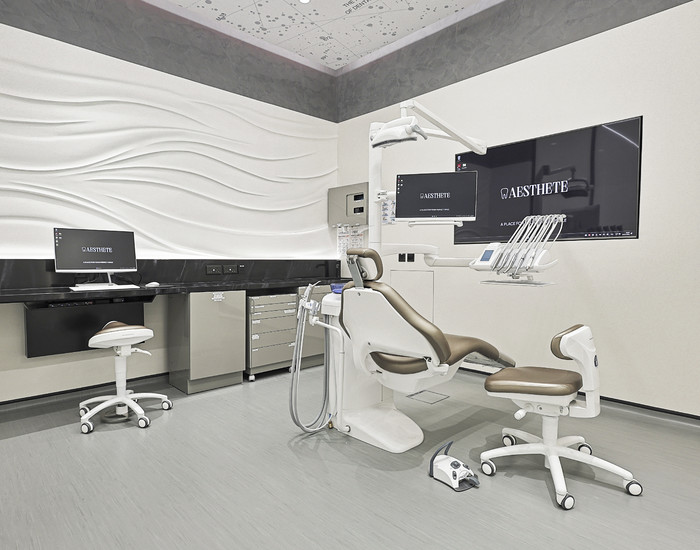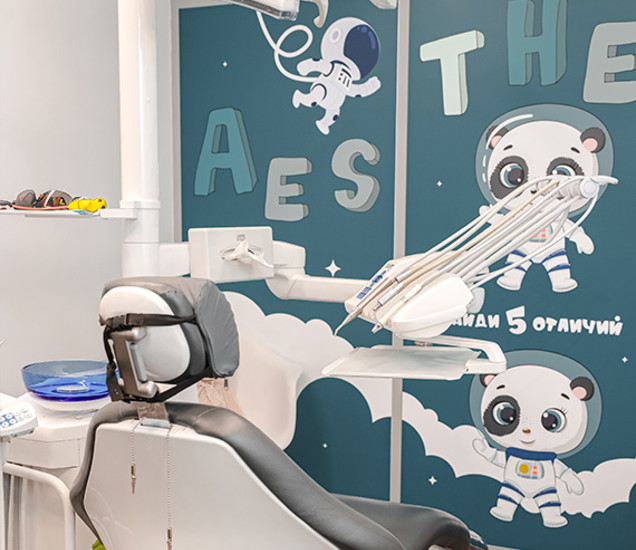How we can be
useful to you:
Veneers Without Grinding
Pediatric dentistry
Correction of bite
Implantation and crowns
Causes of Stains
Tooth pigmentation occurs under the influence of various factors.
The most common cause is the consumption of staining products and beverages. Coffee, tea, red wine, fresh berries, and soy sauce contain strong pigments that gradually penetrate the tooth enamel.
Smoking is another serious factor: under the influence of resins and nicotine found in tobacco smoke, a persistent yellow-brown coating forms.
Some medications, such as tetracycline, can cause internal staining of tooth tissues with prolonged use.
An excess of fluoride in water leads to the appearance of white or brown spots.
Aging changes also play a role: over the years, enamel thins, and dentin darkens, giving teeth a yellowish tint.
One should not forget about hygiene. Irregular or improper tooth brushing contributes to the accumulation of soft plaque, which hardens and stains over time.
Tooth injuries can sometimes provoke darkening due to pulp damage or internal bleeding.
It is advisable to get rid of pigmentation. Even if it does not indicate diseases, a smile with numerous dark spots looks unattractive. This is especially important for those whose work involves contact with people or public speaking. Children and teenagers may face difficulties in communicating with others due to spots. In this case, they develop psychological problems, become withdrawn, and struggle with their studies. As a result, the quality of life decreases.
Types of Stains on Teeth
Pigmentation can be external and internal.
External stains affect only the surface of the enamel. They are usually yellow, brown, or orange. The reasons for the frequent occurrence of such stains include:
- eating habits: for example, excessive consumption of coffee and strong tea;
- smoking;
- improper or insufficiently effective oral hygiene.
This type of pigmentation responds well to professional cleaning.
Internal stains form within the tooth tissues. They can be:
- white — in the case of fluorosis;
- gray — after an injury;
- brown — due to regular intake of tetracycline;
- even greenish — in some infections, as well as due to hormonal disorders or deficiencies of certain minerals and vitamins.

These defects are more difficult to eliminate, as they are not related to surface staining.
It is worth noting chalky spots — the first signs of caries. They appear due to demineralization of the enamel and look like matte white areas. If treatment is not started in time, they will gradually darken, and carious cavities will appear in their place.
Dental stains removal
-
Title
Price
-
Enamel caries treatment with Icon method
from 450 AED
We are changing
people's lives
How to Remove Stains from Teeth
The method of removing pigmentation depends on its type. For getting rid of surface plaque, professional ultrasonic cleaning or Air Flow technology is effective - in this case, a mixture of air, water, and abrasive powder is applied to the teeth under pressure. These procedures safely remove deposits and restore the natural color of tooth enamel.
If you need to remove more stubborn external stains, whitening is used. Laser or Zoom whitening provides quick results - teeth become lighter by several shades in one session. An alternative solution is trays filled with gels. They need to be worn on the teeth for the time set by the dentist. They work more slowly but are also effective.
Remember: the natural shade of enamel varies among individuals, so do not expect "Hollywood" whiteness without consulting a dentist.
Internal discoloration requires different approaches:
- In cases of fluorosis or tetracycline staining, micro-abrasion of the enamel may help - gentle grinding of the surface;
- In complex cases, dentists recommend placing veneers or crowns that completely mask the defect.
If chalky carious spots appear on the enamel, problems can be solved through remineralization. Special compositions with calcium and fluoride strengthen the enamel and prevent further destruction. If the process has progressed too far, treatment with filling will be required.
Factors Affecting Cost
The price of pigmentation removal depends on several factors.
- Method of treatment: simple cleaning will be cheaper than whitening or placing veneers.
- Number of teeth - treating the entire smile costs more than correcting one tooth.
- Complexity of the case - another important point. Eliminating internal discoloration requires more expensive procedures compared to getting rid of surface pigmentation.
Additional costs may arise when preliminary oral cavity sanitation is required. For example, if cavities need to be treated or tartar removed before whitening, this will increase the overall cost of treatment.

Advantages of Professional Stain Removal
Visiting a dental clinic ensures the safety of the procedure. The dentist will select a method that does not damage the enamel, unlike aggressive home remedies. Professional whitening systems provide predictable and long-lasting results, which can last for several years.
Another benefit is a comprehensive approach. The specialist not only removes pigmentation but also identifies its cause. This helps prevent the recurrence of stains. For example, in cases of fluorosis, the dentist may recommend changing the source of drinking water, while for caries, they will prescribe strengthening therapy.
Modern methods of addressing discoloration allow achieving a natural effect. The teeth do not become dazzlingly white but regain a healthy shade without spots and streaks.
To make you healthy,
happy and successful!
will help you with this
Prevention Tips
Monitor your diet to reduce the risk of pigmentation. After consuming staining foods, rinse your mouth with water. It is better to drink coffee and tea through a straw — this will reduce their contact with the enamel. Quitting smoking not only improves the color of your teeth but also enhances overall health.
The foundation of prevention is proper and regular oral hygiene. Brush your teeth twice a day with a soft or medium-bristled toothbrush and a non-abrasive toothpaste. Change your toothbrush every three months and use dental floss to remove plaque from between the teeth.
Regular visits to the dentist will help detect problems early. Professional cleaning every six months will remove plaque that cannot be removed at home. If you are prone to stain formation, the dentist may recommend preventive applications with remineralizing agents.
If you are taking medications that can stain your teeth, discuss possible alternatives with your doctor. For children in regions with high fluoride levels in water, it is advisable to use special filters or bottled water for drinking.
The AESTHETE dental clinic is located in Dubai (UAE), Bluewaters Island. We offer services for removing stains of various colors, shapes, and sizes caused by different reasons. We use modern methods that ensure excellent results and safe procedures. If you have any questions, our clinic administrators will promptly respond and assist with scheduling an appointment.
Sources
- Gasmi Benahmed A, Gasmi A, Menzel A, et al. A review on natural teeth whitening (https://pubmed.ncbi.nlm.nih.gov/34915121/). J Oral Biosci. 2022 Mar;64(1):49-58. Accessed 7/3/2025.
- National Library of Medicine (U.S.). Tooth – abnormal colors (https://medlineplus.gov/ency/article/003065.htm.). Reviewed 3/31/2024. Accessed 7/3/2025.
- Zhu Z, Yu Q, Qi G, et al. Tigecycline-Induced Tooth Discoloration in Children Younger than Eight Years (https://pubmed.ncbi.nlm.nih.gov/34228549/). Antimicrob Agents Chemother. 2021 Aug 17;65(9):e0085421. Accessed 7/3/2025. Advertisement
Evaluate the amazing
results of our clients:
FAQ
Our clinics:
Clinic in Dubai
Resident part, Building 10
Clinic in Moscow
metro Chistye prudy
Clinic in Moscow (Barvikha)
Shopping center "Dream House" 3rd floor
















































_700x550_ac7.jpg)






